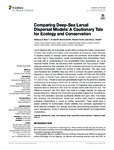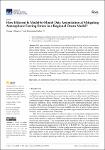Comparing Deep-Sea Larval Dispersal Models: A Cautionary Tale for Ecology and Conservation
| dc.contributor.author | Ross, RE | |
| dc.contributor.author | Nimmo-Smith, Alex | |
| dc.contributor.author | Torres, R | |
| dc.contributor.author | Howell, Kerry | |
| dc.date.accessioned | 2020-12-04T12:39:15Z | |
| dc.date.available | 2020-12-04T12:39:15Z | |
| dc.date.issued | 2020-06-12 | |
| dc.identifier.issn | 2296-7745 | |
| dc.identifier.issn | 2296-7745 | |
| dc.identifier.other | ARTN 431 | |
| dc.identifier.uri | http://hdl.handle.net/10026.1/16708 | |
| dc.description.abstract |
Larval dispersal data are increasingly sought after in ecology and marine conservation, the latter often requiring information under time limited circumstances. Basic estimates of dispersal [based on average current speeds and planktonic larval duration (PLD)] are often used in these situations, usually acknowledging their oversimplified nature, but rarely with an understanding of how oversimplified those assumptions are. Larval dispersal models (LDMs) are becoming more accessible and may produce “better” dispersal predictions than estimates, but the uncertainty introduced by choosing one underlying hydrodynamic model over another is rarely discussed. This case study uses theoretical and simplified deep-sea LDMs to compare the passive predictions of dispersal as driven by two different hydrodynamic models (HYCOM and POLCOMS) and a range of informed basic estimates (based on average current speeds of 0.05, 0.1, and 0.2 m/s). The aim is to provide generalizable insight into the predictive variability introduced by (a) choosing a model over an estimate, and (b) one hydrodynamic over another. LDMs were found to be up to an order of magnitude more conservative in dispersal distance predictions than even the slowest tested estimate (0.05 m/s). The difference increased with PLD which may result in a bigger disparity for deep-sea species predictions. Although the LDMs were more spatially targeted than the estimates, the two LDM predictions were also significantly different from each other. This means that choosing one hydrodynamic model over another could result in contrasting ecological interpretations or advice for marine conservation. These results show a greater potential for hydrodynamic model variability than previously appreciated by larval dispersal ecologists and strongly advocates groundtruthing predictions before use in management. Advice is offered for improved model selection and interpretation of predictions. | |
| dc.format.extent | 431- | |
| dc.language.iso | en | |
| dc.publisher | Frontiers Media SA | |
| dc.subject | hydrodynamic model | |
| dc.subject | larval dispersal model | |
| dc.subject | connectivity | |
| dc.subject | model comparison | |
| dc.subject | biophysical model | |
| dc.subject | deep-sea | |
| dc.title | Comparing Deep-Sea Larval Dispersal Models: A Cautionary Tale for Ecology and Conservation | |
| dc.type | journal-article | |
| dc.type | Journal Article | |
| plymouth.author-url | https://www.webofscience.com/api/gateway?GWVersion=2&SrcApp=PARTNER_APP&SrcAuth=LinksAMR&KeyUT=WOS:000539973500001&DestLinkType=FullRecord&DestApp=ALL_WOS&UsrCustomerID=11bb513d99f797142bcfeffcc58ea008 | |
| plymouth.volume | 7 | |
| plymouth.publication-status | Published online | |
| plymouth.journal | Frontiers in Marine Science | |
| dc.identifier.doi | 10.3389/fmars.2020.00431 | |
| plymouth.organisational-group | /Plymouth | |
| plymouth.organisational-group | /Plymouth/Faculty of Science and Engineering | |
| plymouth.organisational-group | /Plymouth/Faculty of Science and Engineering/School of Biological and Marine Sciences | |
| plymouth.organisational-group | /Plymouth/PRIMaRE Publications | |
| plymouth.organisational-group | /Plymouth/REF 2021 Researchers by UoA | |
| plymouth.organisational-group | /Plymouth/REF 2021 Researchers by UoA/UoA07 Earth Systems and Environmental Sciences | |
| plymouth.organisational-group | /Plymouth/Research Groups | |
| plymouth.organisational-group | /Plymouth/Research Groups/Marine Institute | |
| plymouth.organisational-group | /Plymouth/Users by role | |
| plymouth.organisational-group | /Plymouth/Users by role/Academics | |
| plymouth.organisational-group | /Plymouth/Users by role/Researchers in ResearchFish submission | |
| dcterms.dateAccepted | 2020-05-18 | |
| dc.rights.embargodate | 2020-12-5 | |
| dc.identifier.eissn | 2296-7745 | |
| dc.rights.embargoperiod | Not known | |
| rioxxterms.versionofrecord | 10.3389/fmars.2020.00431 | |
| rioxxterms.licenseref.uri | http://www.rioxx.net/licenses/all-rights-reserved | |
| rioxxterms.licenseref.startdate | 2020-06-12 | |
| rioxxterms.type | Journal Article/Review |



